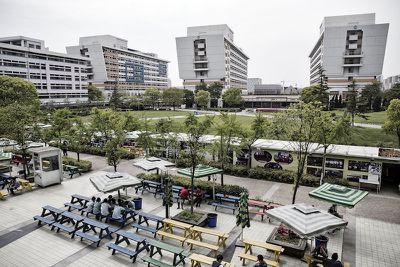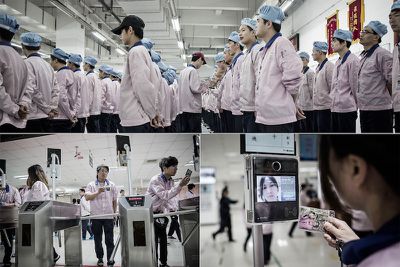Bloomberg has been granted an exclusive look inside a Chinese iPhone manufacturing plant where Apple claimed it has addressed cases of excessive overtime.
Pegatron Corp.'s sprawling facility on the outskirts of Shanghai covers an area equal to 90 football fields and employs some 50,000 people in the iPhone assembly process.
After accusations that employees were forced to work long, grueling hours there, Pegatron and Apple adopted new procedures to keep iPhone assemblers from amassing excessive overtime. By granting a western journalist access to the facility for the first time, both companies appear eager to show how the system works.

In the center of the Pegatron campus is a plaza with a firehouse, police station, and post office. Dotted about are shuttle buses, mega-cafeterias, landscaped lawns, and koi ponds. The grey and brown-hued concrete buildings are meant to evoke traditional Chinese architecture, but the scenes inside them are anything but traditional.
The men and women stare into face scanners and swipe badges at security turnstiles to clock in. The strict ID checks are there to make sure they don't work excessive overtime. The process takes less than two seconds.
After passing through metal detectors to sniff out camera-equipped devices that could be used to leak pictures of unreleased new products, the workers follow arrows on the floor and inspirational posters on the wall. They climb up a stairwell with safety netting draped across the middle, to prevent accidents—or suicide attempts. At a bank of lockers, they don blue hairnets and swap their shoes for clean plastic slip-on slippers. At 9:20 a.m., the 320-worker production unit lines up with military precision in four rows for their roll call.
"Good morning!" they shout in unison under the watchful gaze of the Mayor, who is joined by shift supervisors holding iPads jerry-rigged with black tape. They scan in the workers. Six minutes later, they're on the production floor, assembling smartphones moving past on conveyor belts.
To address accusations of excessive overtime Pegatron adopted the ID system, with badges linked to a database that tracks time, wages and even expenditures on dorm fees and lunch. The Taiwanese company claims the arrangement has helped to push compliance with overtime regulations to almost 100 percent, with only a handful of exceptions stemming from engineers working on emergency repairs.

However, Li Qiang, executive director at labor rights group China Labor Watch (CLW), claims that the ID checks are just for show, "otherwise there wouldn't be so many cases with hundreds of workers putting in excessive overtime hours." CLW claims that base pay remains so low that workers need overtime simply to make ends meet. It said 1,261 pay stubs from Pegatron’s Shanghai facility from September and October 2015 show evidence of excessive overtime.
Pegatron said the group miscounted because that period straddled state holidays, when pay was triple the normal rate. Apple and Pegatron said they were never contacted by CLW, which said it approached Apple but didn't get a response. Since March, the group claims to have collected an additional 441 pay stubs that point to continued excessive overtime. Pegatron said it adheres to the Electronic Industry Citizenship Coalition's guidelines that cap overtime at roughly 80 hours a month.
In 2013, Pegatron came under fire from CLW after the death of five young workers at its Shanghai facilities, including the passing of a 15-year-old factory worker due to pneumonia-related causes. The boy was able to secure a job at a Pegatron factory by presenting a fake ID stating that he was 20. Apple sent a medical team to the Pegatron facility and determined that the worker's death was not related to working conditions.
The same year, CLW alleged numerous safety and workplace violations at Pegatron, including the unethical holding of worker pay and identification cards, as well as poor living conditions within the factory including tight living quarters and packed cafeterias. Apple replied to the allegations, confirming various labor violations and vowing to investigate the incident.
"The fact they let a reporter in shows that they are responding to external pressure and trying to be more transparent – at least on the surface they're trying to fix something," said Jenny Chan, a lecturer at Oxford's Kellogg College. "But they're still not telling us more about how they run the business, the whole labor system."
Note: Due to the political nature of the discussion regarding this topic, the discussion thread is located in our Politics, Religion, Social Issues forum. All forum members and site visitors are welcome to read and follow the thread, but posting is limited to forum members with at least 100 posts.






















Top Rated Comments
Ps. You didn't align my FaceTime camera correctly.